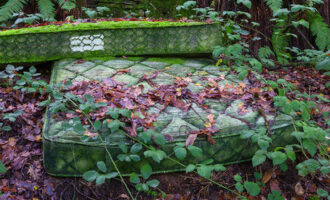Have you ever fallen asleep in one place and woken up somewhere else entirely? Maybe you went to bed in your bedroom like usual, and then woke up on your living room sofa. Or maybe you’ve seen a partner, child, or other loved one sleepwalking and not known how to help. Sleepwalking can be mysterious and a little scary since we’re not in control of our bodies.
Fortunately, sleepwalking doesn’t have to be frightening, and it’s generally not dangerous. Let’s dive into what sleepwalking is, who’s most at risk, and how you can take care of yourself to ensure a safe night’s sleep.
What is sleepwalking?
Sleepwalking, also known as “somnambulism”, is a sleep disorder that causes our bodies to carry out complex physical activity while we’re unconscious. Although the condition is commonly associated with walking, it can cover other activities, too. These may include getting dressed, preparing meals, moving furniture, or other day-to-day activities. In extreme cases, a sleep walker may even try to operate a vehicle, mimicking their standard work commute.
Episodes of somnambulism can last between a few minutes and about half an hour, though they most commonly last about ten minutes. Sleepwalking only happens in your deepest cycle of NREM (non-rapid eye movement) sleep. At this point, you’re at your most distant from your body; however, once you go into REM (rapid eye movement) sleep, your body becomes stationary. It’s thought that our brains temporarily paralyse our bodies so that we don’t physically act out the events of our dreams.
What causes sleepwalking?
Sleepwalking can be caused by a number of factors including age, genetics, and lifestyle. Let’s take a closer look at what causes people to sleepwalk.
People at highest risk of sleepwalking
Sleepwalking is much more common in children than in adults. Most children who sleepwalk outgrow their somnambulism by the time they reach their teen years. Sleepwalking in adults is relatively rare.
In addition, there’s been a proven genetic link between sleepwalkers — if your parents or grandparents were known for moving around in their sleep, it’s likely you or your children will too. If you have a history of sleepwalking in your family, consider adding extra protection to your child’s sleeping space in case they start exhibiting signs of somnambulism, too.
External factors that cause sleepwalking
In addition to age and genetics, sleepwalking can be triggered by external factors including:
- Extreme stress
- Certain sleep medications
- Pre-existing sleep disorders, such as sleep apnea
- Migraines or violent head injuries
- Fevers or other illnesses
- Heavy substance abuse
Any combination of these can lead to the body acting out while it sleeps, so extra care should be taken to provide a safe sleeping space.
Is sleepwalking dangerous?
In general, sleepwalking isn’t inherently harmful. However, there are some circumstances in which sleepwalking can become hazardous or detrimental to your health. If you or a loved one has started sleepwalking, keep an eye out for these potential risks.
Creating dangerous situations
Since we’re not in conscious control of our bodies while we sleepwalk, we can put ourselves in dangerous circumstances. This might be something like going up and down stairs, using sharp tools to prepare a meal, operating a vehicle, or even just wandering outside without being fully aware of your surroundings.
If you notice a child or a partner sleepwalking at night, consider ways to create a safer environment and limit any risks. This might include things like locking cutlery drawers with zip straps or blocking off stairwells.
Negatively impacting sleep health
If your body is often active during your sleep, you might find that you’re not getting a very fulfilling rest during the night. This can make you feel (and act!) like you got a lot less sleep than you really did. Not getting enough sleep can negatively impact our health and well-being in just about every aspect of our waking life, including mood, susceptibility to illness, cognitive ability, and interpersonal skills.
When somnambulism begins impacting your sleep health and your ability to get the most benefits from your sleep cycle, it’s a good idea to seek advice from a medical professional.
Treatments for sleepwalking
Unfortunately, there is no miracle pill for sleepwalking. The good news is that about three quarters of children who experience sleepwalking will grow out of it before they reach adulthood. This means only twenty-five percent of sleepwalking cases persist beyond teenage years.
If you’re concerned about your child sleepwalking, the best thing to do is remove all potential hazards and create a safe space for them while they sleep. This means giving them a ground-level bed to sleep in, rather than a bunk or elevated bed; keeping the area tidy to remove any tripping hazards; keeping windows and doors locked so your child can’t get outside; installing barriers against dangerous areas, such as staircases; and keeping sharp, potentially dangerous objects out of reach.
If sleepwalking is having a negative impact on your health and overall well-being, a safe sleep space — physically and emotionally — is just as important. Since sleepwalking is often born out of stress, taking what steps you can to reduce anxiety and create a welcoming sleep environment can have a huge impact. You can also ask a doctor to prescribe some sleep medications that will help reduce sleepwalking and invite a deeper sleep.
If you come across a child or partner who’s been sleepwalking, you can usually guide them back to bed fairly easily; sleepwalkers are generally very suggestible. Contrary to popular belief, you can wake up someone who’s sleepwalking as long as it’s done gently and slowly. A sleepwalker may experience confusion, disorientation, or dizziness when they’re jolted from a sleepwalking episode. If you’re worried about their immediate safety, however, it’s a good idea to calmly wake them and get them back into their bed.
Manage sleepwalking safely and responsibly
It’s normal to be worried if you find yourself or someone you love becoming unconsciously active at night. However, sleepwalking is generally harmless as well as temporary. Always make sure your sleep environment and the sleeping space of those you love are safe, welcoming, relaxing places free of potential safety hazards. With these tips in mind, you and your family can rest easier in both body and mind.





